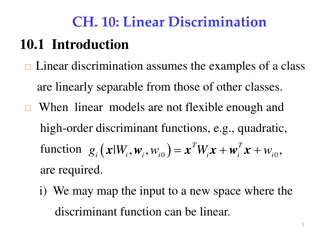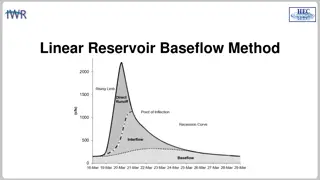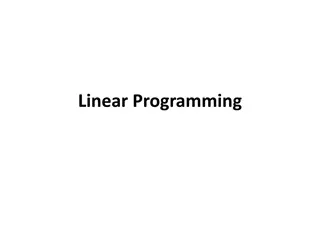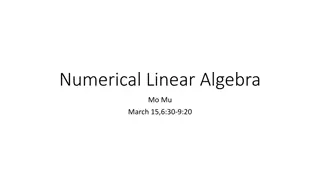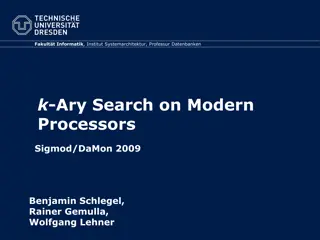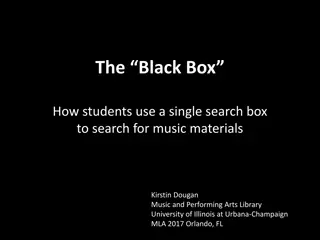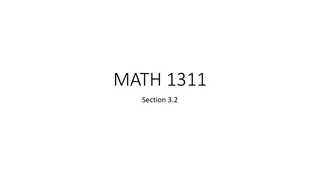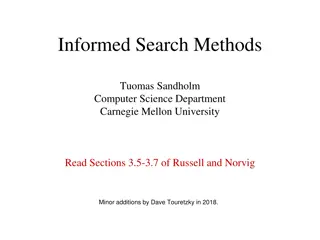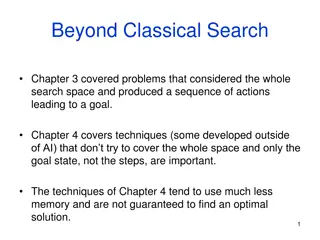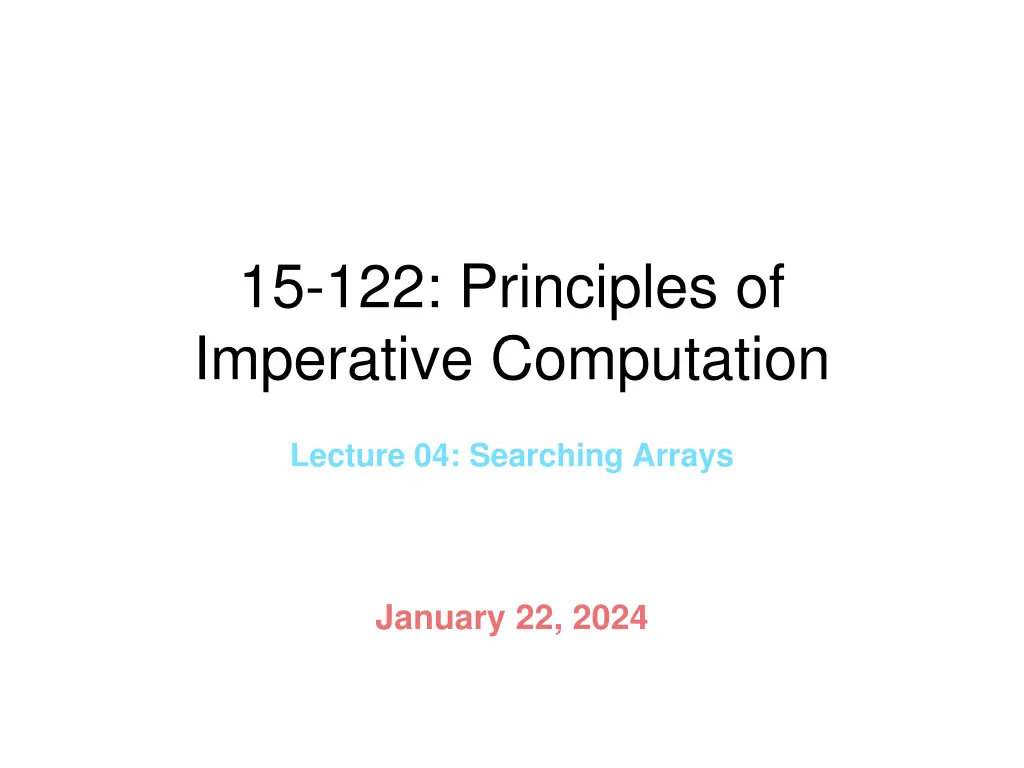
Principles of Imperative Computation: Searching Arrays Lecture Summary
Explore the concepts of searching arrays in imperative computation, covering linear search algorithms, safety considerations, and handling scenarios where the element is not found. Dive into array memory models, coding techniques, and unit testing best practices. Stay informed about assignment deadlines and grade releases.
Download Presentation

Please find below an Image/Link to download the presentation.
The content on the website is provided AS IS for your information and personal use only. It may not be sold, licensed, or shared on other websites without obtaining consent from the author. If you encounter any issues during the download, it is possible that the publisher has removed the file from their server.
You are allowed to download the files provided on this website for personal or commercial use, subject to the condition that they are used lawfully. All files are the property of their respective owners.
The content on the website is provided AS IS for your information and personal use only. It may not be sold, licensed, or shared on other websites without obtaining consent from the author.
E N D
Presentation Transcript
15-122: Principles of Imperative Computation Lecture 04: Searching Arrays January 22, 2024
Today Last lecture: Arrays Memory model, coding with arrays, safety of array code, and effects of array code Today s lecture: Searching Arrays Linear search, correctness, and unit testing Announcements: Grades of written assignment 1 are out Written assignment 2 is due today by 9:00PM Programming assignment 2 is due on Thursday, Jan 25 by 9:00PM 1
Searching for an Element in an Array x: 5 Find where x occurs in A o Return some index where x appears o E.g., For x=5, return 3 0 1 2 3 4 A: 7 3 12 5 8 Linear search algorithm: o Look for x in each place until we find it First attempt: int search(int x, int[] A, int n) { for (int i = 0; i < n; i++) { if (A[i] == x) return i; } } 3
Searching for an Element in an Array x: 5 Remember safety! o A[i]: i should be provably in bounds o n is the length of A 0 1 2 3 4 A: 7 3 12 5 8 int search(int x, int[] A, int n) { for (int i = 0; i < n; i++) { if (A[i] == x) return i; } } 4
Searching for an Element in an Array x: 5 Remember safety! o A[i]: i should be provably in bounds o n is the length of A 0 1 2 3 4 A: 7 3 12 5 8 Add contracts! int search(int x, int[] A, int n) //@requires n == \length(A); { for (int i = 0; i < n; i++) //@loop_invariant 0 <= i; { if (A[i] == x) return i; } } int search(int x, int[] A, int n) { for (int i = 0; i < n; i++) { if (A[i] == x) return i; } } 5
Searching for an Element in an Array x: 4 What if x does not occur in A? o Return something that cannot possibly be an index o -1 0 1 2 3 4 A: 7 3 12 5 8 int search(int x, int[] A, int n) //@requires n == \length(A); { for (int i = 0; i < n; i++) //@loop_invariant 0 <= i; { if (A[i] == x) return i; } } int search(int x, int[] A, int n) //@requires n == \length(A); { for (int i = 0; i < n; i++) //@loop_invariant 0 <= i; { if (A[i] == x) return i; } return -1; } 6
Searching for an Element in an Array x: 12 How will a caller use search? o Check if x is in A I.e., If the returned value is not -1 o If so, do something with that position E.g., Update the value 0 1 2 3 4 A: 7 3 12 5 8 Caller int search(int x, int[] A, int n) //@requires n == \length(A); { for (int i = 0; i < n; i++) //@loop_invariant 0 <= i; { if (A[i] == x) return i; } return -1; } int k = search(12, A, 5); if (k != -1) { A[k] = 13; // Change 12 to 13 } 7
Searching for an Element in an Array x: 12 How does the caller know how search behaves? o That -1 is a valid returned value o That A[k] contains 12 Add postconditions! 0 1 2 3 4 A: 7 3 12 5 8 int search(int x, int[] A, int n) //@requires n == \length(A); /*@ensures \result == -1 || A[\result] == x; @*/ { for (int i = 0; i < n; i++) //@loop_invariant 0 <= i; { if (A[i] == x) return i; } return -1; } Caller int k = search(12, A, 5); if (k != -1) { A[k] = 13; // Change 12 to 13 } Multiline contract 8
Searching for an Element in an Array x: 12 Can we be sure that A[\result] is safe? o Extend the postcondition 0 1 2 3 4 A: 7 3 12 5 8 int search(int x, int[] A, int n) //@requires n == \length(A); /*@ensures \result == -1 || (0 <= \result && \result < n && A[\result] == x); @*/ { for (int i = 0; i < n; i++) //@loop_invariant 0 <= i; { if (A[i] == x) return i; } return -1; } A[\result] == x won t be called if \result is out of bounds && short-circuits evaluation 9
Searching for an Element in an Array x: 12 Is search correct? o That the postconditions are met when the preconditions hold o We have to prove it 0 1 2 3 4 A: 7 3 12 5 8 later int search(int x, int[] A, int n) //@requires n == \length(A); /*@ensures \result == -1 || (0 <= \result && \result < n && A[\result] == x); @*/ { for (int i = 0; i < n; i++) //@loop_invariant 0 <= i; { if (A[i] == x) return i; } return -1; } Does search do what we expect? o I.e., Find x in A o Looks plausible 10
Contract Exploits x: 12 Is this version of search correct? o That postconditions are met when preconditions hold o Definitely! 0 1 2 3 4 A: 7 3 12 5 8 int search(int x, int[] A, int n) //@requires n == \length(A); /*@ensures \result == -1 || (0 <= \result && \result < n && A[\result] == x); @*/ { return -1; // Always returns -1 } Does it do what we expect? o I.e., Find x in A o No!!!! This is a contract exploit o Postconditions are met when preconditions hold The function is correct o But it does not do what we expect 11
Fixing this Contract Exploit x: 12 We want search to return -1 only if x does not occur in A o Strengthen the postcondition to say just that o !is_in(x, A, 0, n) 0 1 2 3 4 A: 7 3 12 5 8 int search(int x, int[] A, int n) //@requires n == \length(A); /*@ensures (\result == -1 && !is_in(x, A, 0, n)) || (0 <= \result && \result < n && A[\result] == x); @*/ { } x does not occur in A between indices 0 and n 12
Array Segments, in Math 0 lo hi length of A A: A[lo, hi) Segment of array A between index lo included and index hi excluded Examples: A[1, 4) contains 3, 12, 5 A[2, 3) contains 12 A[0,5) is the entire array A A[3, 3) does not contain any element; It is an empty segment A[4, 2) does not make sense We want: 0 lo hi length of A 0 1 2 3 4 A: 7 3 12 5 8 13
Fixing this Contract Exploit x: 12 We want search to return -1 only if x does not occur in A o Strengthen the postcondition to say just that o !is_in(x, A, 0, n) 0 1 2 3 4 A: 7 3 12 5 8 int search(int x, int[] A, int n) //@requires n == \length(A); /*@ensures (\result == -1 && !is_in(x, A, 0, n)) || (0 <= \result && \result < n && A[\result] == x); @*/ { } x does not occur in A between indices 0 and n I.e., x A[0, n) 14
Fixing this Contract Exploit Let us define x A[lo, hi) recursively, in math false true x A[lo+1, hi) if lo = hi if lo hi and A[lo] = x if lo hi and A[lo] x x A[lo, hi) = Let us implement it as is_in(x, A, lo, hi) o This is a specification function Transcription of math Obviously correct Used interchangeably in proofs Meant to be used in contracts Often recursive Often no postconditions bool is_in(int x, int[] A, int lo, int hi) //@requires 0 <= lo && lo <= hi && hi <= \length(A); { if (lo == hi) return false; return A[lo] == x || is_in(x, A, lo+1, hi); } Then, is_in(x, A, 0, n) implements x A[0, n) 15
Fixing this Contract Exploit Fixed code for search int search(int x, int[] A, int n) //@requires n == \length(A); /*@ensures (\result == -1 && !is_in(x, A, 0, n)) || (0 <= \result && \result < n && A[\result] == x); @*/ { for (int i = 0; i < n; i++) //@loop_invariant 0 <= i; { if (A[i] == x) return i; } return -1; } Is it correct? o Are the postconditions met when the preconditions hold? 16
Correctness 17
Correctness search has two return statements o Both must satisfy the postcondition The postcondition is a disjunction (||) o Satisfying one branch is enough 1. int search(int x, int[] A, int n) 2. //@requires n == \length(A); 3. /*@ensures (\result == -1 && !is_in(x, A, 0, n)) 4. || (0 <= \result && \result < n && A[\result] == x); 5. @*/ 6. { 7. for (int i = 0; i < n; i++) 8. //@loop_invariant 0 <= i; 9. { 10. if (A[i] == x) return i; 11. } 12. return -1; 13. } 18
Correctness (1) return i on line 10 o To show: If n = \length(A), then either \result = -1 && x A[0, n) or 0 \result < n && A[\result] = x Looks promising A. \result = i B. 0 i C. i < n D. A[i] = x by line 10 by line 8 by line 7 by line 10 1. int search(int x, int[] A, int n) 2. //@requires n == \length(A); 3. /*@ensures (\result == -1 && !is_in(x, A, 0, n)) 4. || (0 <= \result && \result < n && A[\result] == x); 5. @*/ 6. { 7. for (int i = 0; i < n; i++) 8. //@loop_invariant 0 <= i; 9. { 10. if (A[i] == x) return i; 11. } 12. return -1; 13. } 19
Correctness (1) return i on line 10 pre o To show: if n = \length(A), then either \result = -1 && x A[0, n) or 0 \result < n && A[\result] = x LI A. \result = i B. 0 i C. i < n D. A[i] = x by line 10 by line 8 by line 7 by line 10 true loop guard fa lse loop body We did not use EXIT o When we return inside the loop, the loop invariant is not checked again post 20
Correctness (2) return -1 on line 12 o To show: if n = \length(A), then either \result = -1 && x A[0, n) or 0 \result < n && A[\result] = x Must be this one (makes no sense) We must prove x A[0, n) o No point-to argument to do so! 1. int search(int x, int[] A, int n) 2. //@requires n == \length(A); 3. /*@ensures (\result == -1 && !is_in(x, A, 0, n)) 4. || (0 <= \result && \result < n && A[\result] == x); 5. @*/ 6. { 7. for (int i = 0; i < n; i++) 8. //@loop_invariant 0 <= i; 9. { 10. if (A[i] == x) return i; 11. } 12. return -1; 13. } math for !is_in(x, A, 0, n) 21
Correctness (2) What do we know as we start iteration i of the loop? 0 i n A: x A[0, i) o x A[0, i) o Why? Because we looked at A[0, i) and didn t find x This is something we believe to be true at every iteration of the loop o A loop invariant! o Well, a candidate loop invariant We need to prove it is valid 22
Correctness (2) return -1 on line 13 o To show: if n = \length(A), then either \result = -1 && x A[0, n) or 0 \result < n && A[\result] = x Must be this one We still need to prove 1. x A[0, i) is a valid loop invariant 2. x A[0, n) 1. int search(int x, int[] A, int n) 2. //@requires n == \length(A); 3. /*@ensures (\result == -1 && !is_in(x, A, 0, n)) 4. || (0 <= \result && \result < n && A[\result] == x); 5. @*/ 6. { 7. for (int i = 0; i < n; i++) 8. //@loop_invariant 0 <= i; 9. //@loop_invariant !is_in(x, A, 0, i); 10. { 11. if (A[i] == x) return i; 12. } 13. return -1; 14. } 23
bool is_in(int x, int[] A, int lo, int hi) //@requires 0 <= lo <= hi <= \length(A); { if (lo == hi) return false; return A[lo] == x || is_in(x, A, lo+1, hi); } Correctness (2) x A[0, i) is a valid loop invariant INIT: To show: x A[0, i) initially A. i = 0 B. x A[0, 0) == false by definition of is_in C. x A[0, i) == true by line 7 by math 1. int search(int x, int[] A, int n) 2. //@requires n == \length(A); 3. /*@ensures ( !is_in(x, A, 0, n)) 4.|| ; 5. @*/ 6. { 7. for (int i = 0; i < n; i++) 8. //@loop_invariant 0 <= i; 9. //@loop_invariant !is_in(x, A, 0, i); 10. { 11. if (A[i] == x) return i; 12. } 13. return -1; 14. } o A[0,0) is the empty array segment Nothing is in it 24
bool is_in(int x, int[] A, int lo, int hi) //@requires 0 <= lo <= hi <= \length(A); { if (lo == hi) return false; return A[lo] == x || is_in(x, A, lo+1, hi); } Correctness (2) x A[0, i) is a valid loop invariant PRES: To show: If x A[0, i), then x A[0, i ) A.i = i+1 B.x A[0, i+1) iff x A[0, i) and A[i] x C.x A[0, i) D.A[i] = x ? a) If true: We return on line 11 We exit the function We won t check the loop invariant again b) If false: We continue with the loop We will check the loop invariant again x A[0, i+1) by line 7 by def. of is_in by assumption 1. int search(int x, int[] A, int n) 2. //@requires n == \length(A); 3. /*@ensures ( !is_in(x, A, 0, n)) 4.|| ; 5. @*/ 6. { 7. for (int i = 0; i < n; i++) 8. //@loop_invariant 0 <= i; 9. //@loop_invariant !is_in(x, A, 0, i); 10. { 11. if (A[i] == x) return i; 12. } 13. return -1; 14. } by B, C, D(b) When returning from inside a loop, we don t need to show preservation 25
Correctness (2) return -1 on line 13 We must prove 1. x A[0, i) is a valid loop invariant 2. x A[0, n) 1. int search(int x, int[] A, int n) 2. //@requires n == \length(A); 3. /*@ensures (\result == -1 && !is_in(x, A, 0, n)) 4. || (0 <= \result && \result < n && A[\result] == x); 5. @*/ 6. { 7. for (int i = 0; i < n; i++) 8. //@loop_invariant 0 <= i; 9. //@loop_invariant !is_in(x, A, 0, i); 10. { 11. if (A[i] == x) return i; 12. } 13. return -1; 14. } 26
Correctness (2) return -1 on line 13 We must still prove x A[0, n) o When the loop terminates, we know that x A[0, i) by line 9 i n by line 7 1. int search(int x, int[] A, int n) 2. //@requires n == \length(A); 3. /*@ensures ( !is_in(x, A, 0, n)) 4.|| ; 5. @*/ 6. { 7. for (int i = 0; i < n; i++) 8. //@loop_invariant 0 <= i; 9. //@loop_invariant !is_in(x, A, 0, i); 10. { 11. if (A[i] == x) return i; 12. } 13. return -1; 14. } To conclude x A[0, n) we need i = n Add i n as another loop invariant o Is it valid? Left as exercise 27
Correctness (2) return -1 on line 13 We must still prove x A[0, n) o When the loop terminates, we know that A. x A[0, i) by line 9 B. i n by line 7 C. i n by line 8 D. i = n by B, C E. x A[0, n) by A, D 1. int search(int x, int[] A, int n) 2. //@requires n == \length(A); 3. /*@ensures ( !is_in(x, A, 0, n)) 4.|| ; 5. @*/ 6. { 7. for (int i = 0; i < n; i++) 8. //@loop_invariant 0 <= i && i <= n; 9. //@loop_invariant !is_in(x, A, 0, i); 10. { 11. if (A[i] == x) return i; 12. } 13. return -1; 14. } 28
Scope When the loop terminates, we know that D. i = n by B, C We cannot record this with an //@assert o The variable i is not defined outside of the for loop o This mention of i would be out of scope 1. int search(int x, int[] A, int n) 2. //@requires n == \length(A); 3. /*@ensures ( !is_in(x, A, 0, n)) 4.|| ; 5. @*/ 6. { 7. for (int i = 0; i < n; i++) 8. //@loop_invariant 0 <= i && i <= n; 9. //@loop_invariant !is_in(x, A, 0, i); 10. { 11. if (A[i] == x) return i; 12. } 13. //@assert i == n; 14. return -1; 15. } Compilation error 29
Final Code for search int search(int x, int[] A, int n) //@requires n == \length(A); /*@ensures (\result == -1 && !is_in(x, A, 0, n)) || (0 <= \result && \result < n && A[\result] == x); @*/ { for (int i = 0; i < n; i++) //@loop_invariant 0 <= i && i <= n; //@loop_invariant !is_in(x, A, 0, i); { if (A[i] == x) return i; } return -1; } We proved it safe and correct Does it do what we expect? o Yes! 30
Testing 31
Client View A caller of search can only rely on its contracts int search(int x, int[] A, int n) //@requires n == \length(A); /*@ensures (\result == -1 && !is_in(x, A, 0, n)) || (0 <= \result && \result < n && A[\result] == x); @*/ ; o We may not be able to see the source code It may have been written by someone else It may be part of a library This is the prototype of this function Can there be an implementation that satisfies these contracts but does not do what we expect? An implementation that is correct, but wrong o Can there be contract exploits? 32
More Contract Exploits int search(int x, int[] A, int n) //@requires n == \length(A); /*@ensures (\result == -1 && !is_in(x, A, 0, n)) || (0 <= \result && \result < n && A[\result] == x); @*/ { for (int i = 0; i < n; i++) //@loop_invariant 0 <= i && i <= n; //@loop_invariant !is_in(x, A, 0, i); { A[i] = x; // puts x in A[0] if (A[i] == x) return i; // and returns } return -1; } 33
Even More Contract Exploits int search(int x, int[] A, int n) //@requires n == \length(A); /*@ensures (\result == -1 && !is_in(x, A, 0, n)) || (0 <= \result && \result < n && A[\result] == x); @*/ { for (int i = 0; i < n; i++) //@loop_invariant 0 <= i && i <= n; //@loop_invariant !is_in(x, A, 0, i); { A[i] = x + 1; // puts x+1 everywhere if (A[i] == x) return i; // will never return here } return -1; } 34
Protecting against Contract Exploits The function changes the array o The caller has no way to know based on contracts What to do? o Write stronger contracts? Check that the array doesn t change In practice: Write strong contracts o Use them to reason about your code Do thorough unit testing o With contracts being on o Unit testing Call search with a variety of inputs and check that it returns the expected value Usually impractical to test with all possible inputs Look for inputs where errors are likely to occur 35
Testing C0 Functions Create a test file and write tests in its main function int main() { Creates test array A = [3, -7] For each test o Define input values o Use assert to check that the function returns the expected result // Test #1 int[] A = alloc_array(int, 2); A[0] = 3; A[1] = -7; assert(search(3, A, 2) == 0); assert(search(-7, A, 2) == 1); assert(search(42, A, 2) == -1); assert(A[0] == 3); assert (A[1] == -7); A wasn t changed A wasn t changed return 0; } 36
Testing C0 Functions assert o Aborts execution if its argument evaluates to false o Continues to the next line if it evaluates to true int main() { // Test #1 int[] A = alloc_array(int, 2); A[0] = 3; A[1] = -7; assert(search(3, A, 2) == 0); assert(search(-7, A, 2) == 1); assert(search(42, A, 2) == -1); assert(A[0] == 3); assert (A[1] == -7); assertis not a contract o It is run even when compiling without -d o We cannot use \length in it return 0; } //@assert is a contract o It is run only when compiling with -d o We can use \length in it 37
Testing C0 Functions Test as many edge cases as possible int main() { // Test #2 int[] B = alloc_array(int, 4); for (int i=0; i<4; i++) B[i] = i+10; assert(search(10, B, 4) == 0); assert(search(13, B, 4) == 3); Edge cases are inputs at the edge of the expected input range o First element of an array o Last element of an array o Empty array o 1-element array Creates test array B = [10, 11, 12, 13] 10 is the first element of B and 13 the last element // Test #3 int[] C = alloc_array(int, 0); assert(search(8, C, 0) == -1); Nothing is in the empty array // Test #4 int[] D = alloc_array(int, 1); D[0] = 122; assert(search(122, D, 1) == 0); } Testing a 1-element array 38
Testing C0 Functions Test inputs that are easily mishandled o Sorted arrays With values that are Too small Too big Just right int main() { // Test #5 int[] E = alloc_array(int, 6); for (int i=0; i<6; i++) E[i] = i+1; assert(search(-3, E, 6) == -1); assert(search(4, E, 6) == 3); assert(search(9, E, 6) == -1); E is the sorted array E = [1, 2, 3, 4, 5, 6] // Test #6 int[] F = alloc_array(int, 6); for (int i=0; i<6; i++) F[i] = 6-i; assert(search(-3, F, 6) == -1); assert(search(4, F, 6) == 2); assert(search(9, F, 6) == -1); } F is E in reverse order 39
Testing C0 Functions Include some big inputs and test them systematically o These are called stress tests int main() { // Test #7 int n = 1000000; int[] G = alloc_array(int, n); for (int i=0; i<n; i++) G[i] = 2*i; For big tests, putting the size in a variable makes it easy to modify G contains the first n even numbers for (int i=0; i<n; i++) assert(search(2*i, G, n) == i); G[i] contains 2*i for (int i=0; i<2*n; i++) assert(search(2*i + 1, G, n) == -1); } G contains no odd number o Best would be to use random inputs We will see later how to do that 40
Testing C0 Functions Do not test implementation details o Anything that the function description leaves open-ended int main() { // Test #8 int[] H = alloc_array(int, 5); assert(search(0, H, 5) == 0); H is initialized with the default int H = [0, 0, 0, 0, 0] BAD TEST return 0; } Example: Array with duplicate elements o Nothing tells us the index of which occurrence search will return Our implementation returns the first But other implementations may return The last The middle occurrence A random occurrence int search(int x, int[] A, int n) //@requires n == \length(A); /*@ensures (\result == -1 && !is_in(x, A, 0, n)) || (0 <= \result && \result < n && A[\result] == x); @*/ { for (int i = 0; i < n; i++) //@loop_invariant 0 <= i && i <= n; //@loop_invariant !is_in(x, A, 0, i); { if (A[i] == x) return i; } //@assert !is_in(x, A, 0, n); return -1; } 41

